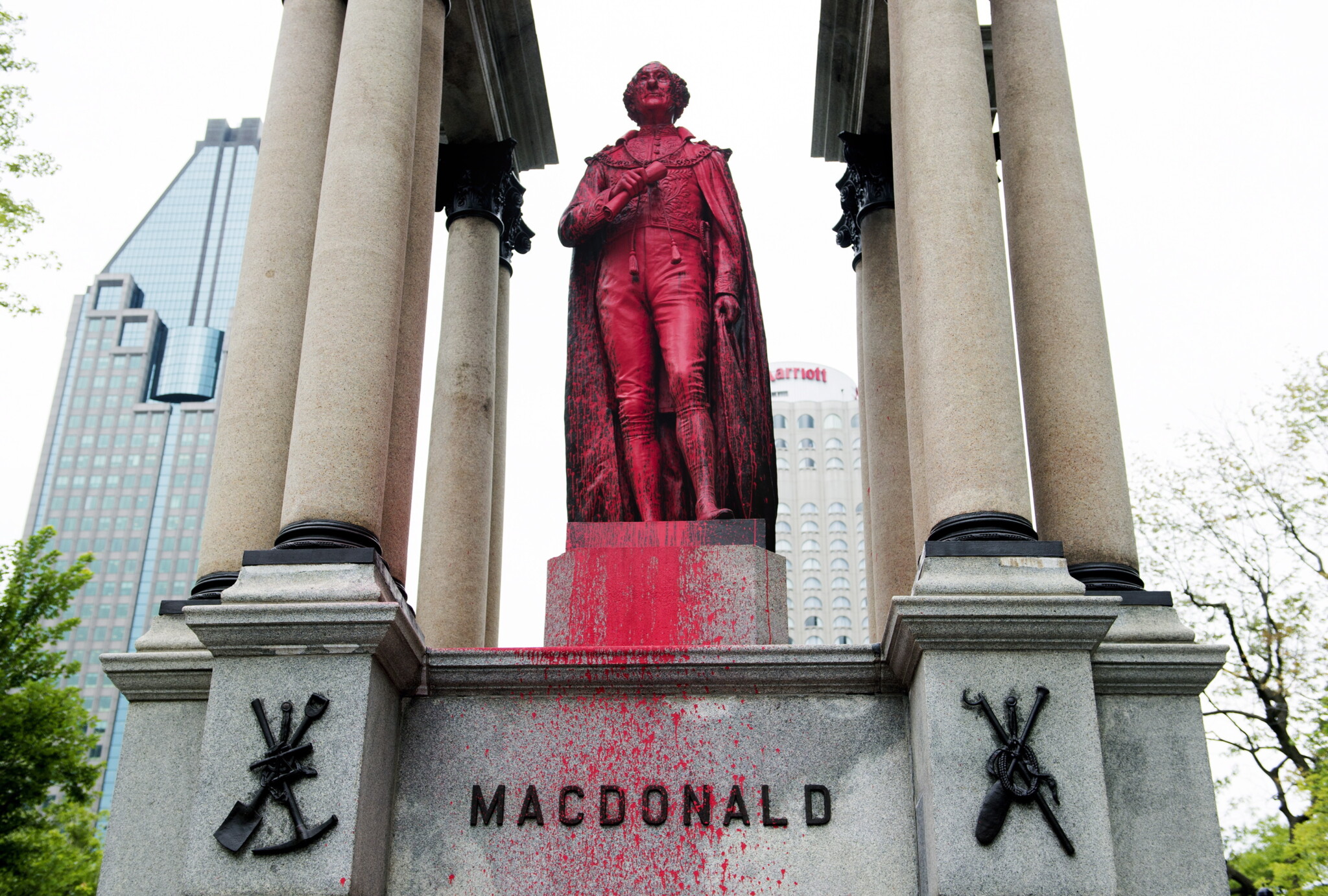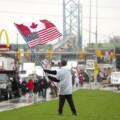“You are about to journey into the past and discover one of the great leaders in history without whom our nation would not exist.”
Thus begins the video at Mount Vernon, the preserved estate of George Washington, the first president of the United States. For those familiar with Canadian history the same words could apply to our first prime minister, Sir John A. Macdonald. But he isn’t receiving that kind of treatment nowadays. Not in this country. He is being crucified.
My wife and I visited Mount Vernon years ago and found it fascinating and teeming with history. Today it’s the most popular historic site in the U.S., and since it opened in 1860 some 96 million people have come. Every year attracts another million. The estate, including the mansion, gardens, and farmlands, once encompassed 8,000 acres along the bank of the Potomac River. Now 500 acres are open to the public and you don’t go away disappointed.
Washington was a general during the American Revolutionary War and in 1789 became the country’s first president. Everything about Mount Vernon is designed to take you back to that time and provide an education about him, his place in history, and his legacy.
He died on Dec. 14, 1799, from a throat infection developed while riding his horse through poor weather. I found it eerie when I was there because his riding boots are on the floor beside his bed as though he were about to walk in at any moment. The tour includes his tomb and that of his wife Martha, as well as the mansion, gardens, gristmill, and distillery. You gain a thorough understanding of him—the general, politician, and businessman.

The Federal Hall statue of George Washington overlooks the New York Stock Exchange, Monday, June 7, 2021. Richard Drew/AP Photo.
To its credit, Mount Vernon no longer whitewashes anything, acknowledging that Washington depended on slave labour to run his estate. In fact, at the age of 11 he inherited 10 slaves from his father, and when he married wealthy widow Martha Custis, the marriage brought 80 more to the union. Mount Vernon had a workforce of several hundred enslaved people. On the grounds today you find a slave memorial, cemetery, and burial ground for enslaved and freed African-Americans connected to Mount Vernon. Visitors can watch videos about the Revolutionary War, slavery, Native Americans, what have you.
Says the introductory video: “Washington’s story is woven into the very fabric of our national identity. He united 13 colonies and helped to create a peaceful, civilian-led government.”
No one is saying Washington was a saint. Saints are pretty hard to find throughout history. But he was significant in more ways than one. The man left his mark. And for the record, upon his death, his will stipulated that those enslaved in his name at Mount Vernon be freed after the death of his widow.
I’m not American, but I felt a tingle in my bones when visiting his estate. There was something of historical value in the air. There is no such feeling at Bellevue House, the one-time home of Macdonald in Kingston, Ontario, which reopened this past spring after being under wraps for six years because of restorations and COVID.
However, what now passes as history on Macdonald at Bellevue House is, put simply, a form of education and indoctrination. It’s clear no effort has been spared to shove ideology down your throat. For lack of a better term, let’s call it “woke history”. It starts when you go on the website.
“Hello. Shé:kon. Aaniin. At Bellevue House National Historic Site, many voices present the complex legacy of Canada’s first prime minister, Sir John A. Macdonald.”
If this is history, it’s through a filtered lens. Actually, Bellevue House has little connection to Macdonald. He rented the house for barely a year long before becoming prime minister, living there with his sickly wife Isabella and first son, also named John, a boy who died in infancy.
The restored house is beautiful, but the impression one gets is that Macdonald was of the upper class and did everything he could to show it. Nothing could be further from the truth. During his brief time in Bellevue House he was struggling to make a living as a lawyer, never mind caring for his wife and being responsible for his unmarried sisters and a mother who had a series of strokes. Like Washington, Macdonald accomplished many things, but suggesting he was a man of wealth—as Washington was—is a pure fallacy.
The house is nicely furnished according to the time period, but there is only one artifact from Macdonald. His son’s crib. However, a great deal is suggested. For example:
“As you move through the house, you will discover that a wealthy Victorian home can offer clues through architecture, furniture, and contents that express the occupants’ power and privilege. You’ll encounter difficult stories about the past and be invited into discussions and moments of personal reflection about how Canada’s future can be more inclusive.”
There is signage at Bellevue House about the internment of Japanese-Canadians during the Second World War. What does that have to do with Macdonald? There are references to slavery, as if what was going on in Upper Canada mirrored what transpired south of the border. In fact, Lieutenant Governor John Graves Simcoe abhorred slavery and in 1793 an Act was passed to prevent the introduction of slaves to Upper Canada, making us the first jurisdiction in the British Commonwealth to do anything like that. The not-so-subtle implication at Bellevue House points to the sorry treatment of anyone in these parts who wasn’t white; that means everything from the head tax on Chinese migrants who worked on the railway to the plight of Indigenous people.
Parks Canada admits that prior to the reopening of Bellevue House it formed working groups with Indigenous partners, culturally diverse members of Kingston, and other “collaborators” to share stories and develop “new exhibit content.” Said Parks Canada in its news release of May 18, 2024:
“Visitors are encouraged to engage with stories that reflect the diverse lives lived in the 1800s, including those of Indigenous, racialized, working-class, and upper-class individuals. Themes of wealth and power, incredible achievements and feats of engineering, and personal loss and tragedy, are interwoven with issues such as colonial expansion, racism, misogyny, and exploitation.”
Outside the house you can take a tour of the gardens with signage along the way. One of the first signs has unattributed statements allegedly made about Macdonald: “He was a monster. He was a product of his time. He’s done some good things and some bad things.”
There is precious little about Macdonald the nation-maker, which is the title of volume two in Richard Gwyn’s award-winning, two-book biography: John A: The Man Who Made Us was published in 2008, and Nation Maker: Sir John A. Macdonald: His Life, Our Times in 2012. What did biographer Gwyn, who spent seven years researching our first PM, have to say about him?
“Any reasonable ranking of nineteenth-century democratic leaders would be Abraham Lincoln, Benjamin Disraeli, William Gladstone, and John A. Macdonald.”
According to Gwyn, when looking at the history of Canada and all its leaders right up to the first decade of the 21st century, “no one else came close to Macdonald.” He said: “Had there been no Macdonald, there almost certainly would be today no Canada. In a great many ways, what Canadians have become began with him. He, a nation-maker, made us.”
Gwyn died in 2020, but if he was alive something tells me he wouldn’t have been one of the “collaborators” consulted by Parks Canada for the reopening of Bellevue House.
As we speak, a statue of Macdonald outside the Ontario Legislature in Toronto remains boarded up. In 2020 in Montreal, his statue was toppled by a mob that cheered when the head came off. Other statues were taken down in Hamilton and Victoria. In Kingston, his statue was removed and in that same city, the Sir John A. Macdonald Parkway has been renamed Kichi Zibi Mikan, which means “Great River Road” in the Algonquin language. Across the land schools bearing his name are making changes. In short, Macdonald is being trashed.

The head of a statue of Sir John A. MacDonald is shown torn down following a demonstration in Montreal, Saturday, Aug. 29, 2020. Graham Hughes/The Canadian Press.
The desecration and removal of statues was too much for a trained historian, Mary Lazier Corbett, whose letter to the editor appeared in the Globe and Mail on June 26, 2023. It began by saying that residential schools were established in 1831 when Macdonald was 16 and were not his creation. She said: “Given Macdonald’s support for various Indigenous communities in his private work, I am saddened by the sloppy historical work that is behind the destruction of his name. If lies continue to replace legitimate history, then his legacy is at serious risk.”
Was there anything at Bellevue House about young lawyer Macdonald defending a black man—a slave—who had escaped from the U.S. only to be arrested in Upper Canada for stealing a horse south of the border? Macdonald said the magistrate who initiated the proceeding should be discharged.
Was there anything about Macdonald pushing for women’s voting rights—in the 1880s—making our Parliament the first legislature in the world to debate the issue?
How about personally writing 50 of the 72 resolutions in the British North America Act which gave Canada nationhood? Or being the only member of a British commission in Washington, D.C. that was discussing trade with the Americans who stood up to fight for Canada? Note: U. S. President Ulysses Grant wanted to annex Canada, and if not for Macdonald, he might have.
British journalist Douglas Murray mentions Macdonald, whom he calls “the nearest thing the country has to a founding father,” in his best-selling book The War on the West. After referring to the statues coming down in the wake of the Black Lives Matter movement, Murray said: “During this strange stampede in Canada, as in so many other cases, the whole history of the country and the wider West became strangely perverted. Both truths and lies were exaggerated and then spun along through a cycle of outrage. Assumptions of obvious guilt were made, followed by a scouring search for culprits to blame.”
Just so you know, Mount Vernon in Virginia accepts no grants from federal, state, or local governments, and no tax dollars support it. Primary sources of income are revenue from its retail and dining facilities, ticket sales, and donations from foundations, corporations, and individuals. Mount Vernon receives one million visitors a year which equates to well over 2,500 a day.
Bellevue House, by contrast, is administered by Parks Canada, an agency of the federal government. That same government and agency issued a news release in 2019 announcing its new “Framework for History and Commemoration: National Historic Sites.” In a nutshell, it’s very heavy on the diverse heritage of the nation and the contributions of Indigenous people. What you see today at Bellevue House is a direct result of that policy.
Like Mount Vernon, Bellevue House offers education programs for schools. If the “Unpacking Macdonald” tour I took is any indication, we can assume our first prime minister is not only unpacked but sealed up in a crate as he is presented to students. This denigrating indoctrination is happening right now in the nation’s schools at all levels—not to mention the federal government.
Canadians should be concerned. No—horrified.
For what it’s worth, we were advised to reserve two spots in advance for that tour. Just to be safe. When the time came, no one else was there. Only us. When I asked how many visitors Bellevue House gets, I was told 70 is a good day. So my overall impression was that historical accuracy, never mind efficiency, does not abound here. But what do you expect when the intent is to steal your history?










